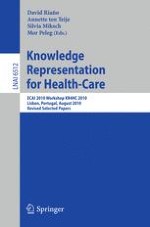2011 | Book
Knowledge Representation for Health-Care
ECAI 2010 Workshop KR4HC 2010, Lisbon, Portugal, August 17, 2010, Revised Selected Papers
Editors: David Riaño, Annette ten Teije, Silvia Miksch, Mor Peleg
Publisher: Springer Berlin Heidelberg
Book Series : Lecture Notes in Computer Science
